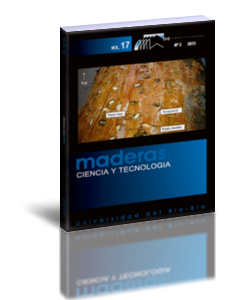Liquefied wood as a partial substitute of melamine-urea-formaldehyde and urea-formaldehyde resins
Keywords:
automated bonding evaluation system, liquefied wood, particleboard, pinus pinaster, resinAbstract
Maritime pine (Pinus pinaster) sawdust was used to produce liquefied wood by the polyhydric method with acid catalysis. The process was optimized to produce the highest amount of liquefied wood. Wood liquefied at 160ºC for 90 min was used in the adhesion tests. The bond strength of veneer glued with urea-formaldehyde and melamine-urea-formaldehyde resins and several mixtures of liquefied wood with urea-formaldehyde and melamine-urea-formaldehyde wasevaluated by automated bonding evaluation system.
With the increase in liquefied wood content the bond strength decreased. Nevertheless for 20% liquefied wood the reduction of internal bond strength is relatively small and still within the minimum standards required. When 70% of liquefied wood is employed there is a significant decrease in bond strength.
In conclusion it is possible to use a small amount of maritime pine sawdust liquefied wood as a partial substitute of urea-formaldehyde and melamine-urea-formaldehyde resins in the particleboard production, thus decreasing the formaldehyde content.
Downloads
Downloads
Published
How to Cite
Issue
Section
License
Copyright (c) 2015 Bruno Esteves, João Martins, Jorge Martins, Luísa Cruz-Lopes, José Vicente, Idalina Domingos

This work is licensed under a Creative Commons Attribution 4.0 International License.
Los autores/as conservarán sus derechos de autor y garantizarán a la revista el derecho de primera publicación de su obra, el cuál estará simultáneamente sujeto a la Licencia de Reconocimiento de Creative Commons CC-BY que permite a terceros compartir la obra siempre que se indique su autor y su primera publicación esta revista.
































